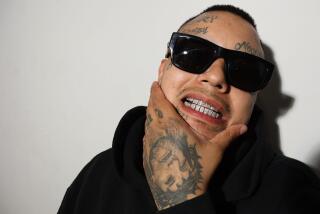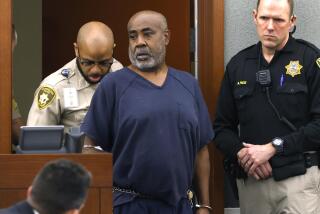Witnesses aid probe of rapper’s slaying
Despite concerns that witnesses would be too fearful to come forward, police investigators said Monday that a number of people have provided valuable information about the gunman who killed rap star Notorious B.I.G.
Detectives declined to elaborate on possible leads, but scheduled a press briefing for Monday evening to “release suspect information” and discuss new developments in the case. That information is expected to include eyewitness descriptions of the rapper’s killer and getaway car in the Sunday morning attack.
“Things are moving along,” said Los Angeles Police Department spokesman Mike Partain. “They haven’t had a problem talking to the people they’re getting ahold of. The witnesses have been very cooperative.”
The 24-year-old rapper, whose real name was Christopher Wallace, was gunned down shortly after midnight Sunday after a music industry party, as he sat in a GMC Suburban parked along Museum Row in Los Angeles’ Mid-Wilshire district.
Wallace was the second so-called gangsta rap sensation in six months to be slain. The other victim was Tupac Shakur, who was killed during a drive-by attack in Las Vegas in September.
Several top record executives said Monday that they were stunned about the assassination of another rap star. They also adamantly rejected the notion that the culture of hip-hop music was responsible in either case.
“This isn’t about music. It’s about territorial gang warfare that has spilled over into the world of hip-hop,” said one executive, who spoke on condition of anonymity. “It’s about the Jets and the Sharks. It’s about the Bloods and the Crips. It’s about the East and the West. It’s a gang war that was going on long before hip-hop was created. Hundreds of inner-city kids get gunned down every month across the U.S.A. This is a horrendous social tragedy that seems only to get noticed when a rap star gets murdered.”
But C. DeLores Tucker, chairwoman of the National Political Congress of Black Women and an outspoken opponent of gangsta rap, said Wallace’s death was “a tragic reminder of the real impact of gangsta rap on our lives. . . . Gangsta rap glorifies violence.”
Police have no motive for Wallace’s slaying, but they have not ruled out the possibility that his death was linked to a feud between Wallace’s East Coast-based Bad Boy Entertainment record label and Los Angeles-based Death Row Records, whose marquee artist was Shakur.
Those in music circles speculated Monday that someone in the West Coast rap community took offense at Wallace’s high-profile presence last Friday at the Soul Train Music Awards and at his appearance at a number of parties around Los Angeles, including Saturday night’s party at the Petersen Automotive Museum, hosted by Vibe Magazine and Qwest Records.
“These gangbanging hangers-on could care less whether the guy they kill is a big star or another gang member,” said one executive. “Once they feel they’ve been dissed, they get violent.”
Music executives said that rap stars often continue to associate with friends from their old neighborhoods who have ties to street gangs.
They said the rappers resist leaving these friends behind and often pay their bills and allow them to live in their residences--similar to the way that rock star Elvis Presley supported a large entourage of his old friends and family members. The difference, the executives said, is that some of the rappers’ friends have no qualms about acting out a grudge and are far more likely to settle disputes with weapons.
Two shows scheduled in West Hollywood on Sunday and Monday by rap star Ice Cube and his group, the Westside Connection, were canceled because his management wanted to show respect for Wallace’s death and avoid the potential of violence in response to the killing, according to a source at the club, Billboard Live.
In the Wallace killing, bad blood dates back to when Shakur accused Wallace--his former friend--of being involved in a 1994 robbery in which Shakur was shot several times and lost $40,000 in jewelry.
Wallace, who also went by the name Biggie Smalls, denied any involvement.
The tension between the two men escalated last year when Shakur taunted Wallace in a song and claimed that he had sex with Wallace’s wife.
Shakur’s shooting remains a mystery. It occurred on the busy Las Vegas Strip, yet few witnesses have come forward to help police.
Because there has been speculation of gang involvement in both slayings, police worried that witnesses might be reluctant to come forward with information out of fear of retaliation. But that apparently was not the case Monday in the Wallace investigation.
More than 1,000 people were said to be at Saturday night’s party.
Wallace, a 6-foot-3 man who weighed 380 pounds, went from a being a drug dealer in Brooklyn to the top of rap music charts with his gritty, reality-based lyrics of gang violence.
Even as a celebrity, he maintained a tough-guy image, which occasionally got him into trouble with the law. In March 1995, he was arrested in New York after allegedly using a baseball bat to deter autograph seekers. A couple of months later, he was arrested for allegedly robbing a man and breaking his jaw in Camden, N.J. Last summer, he was arrested for alleged possession of weapons and marijuana.
Despite his troubles with the law, Wallace’s music career seemed bright. He was honored as rap artist of the year at the Billboard Awards in 1995 and was cited for rap single of the year for “One More Chance.” His debut album, “Ready to Die,” sold more than 1 million copies. His new album, due out in two weeks, is called “Life After Death . . . ‘Til Death Do Us Part.”
Times staff writer Cheo Hodari Coker contributed to this story.
More to Read
Start your day right
Sign up for Essential California for news, features and recommendations from the L.A. Times and beyond in your inbox six days a week.
You may occasionally receive promotional content from the Los Angeles Times.






